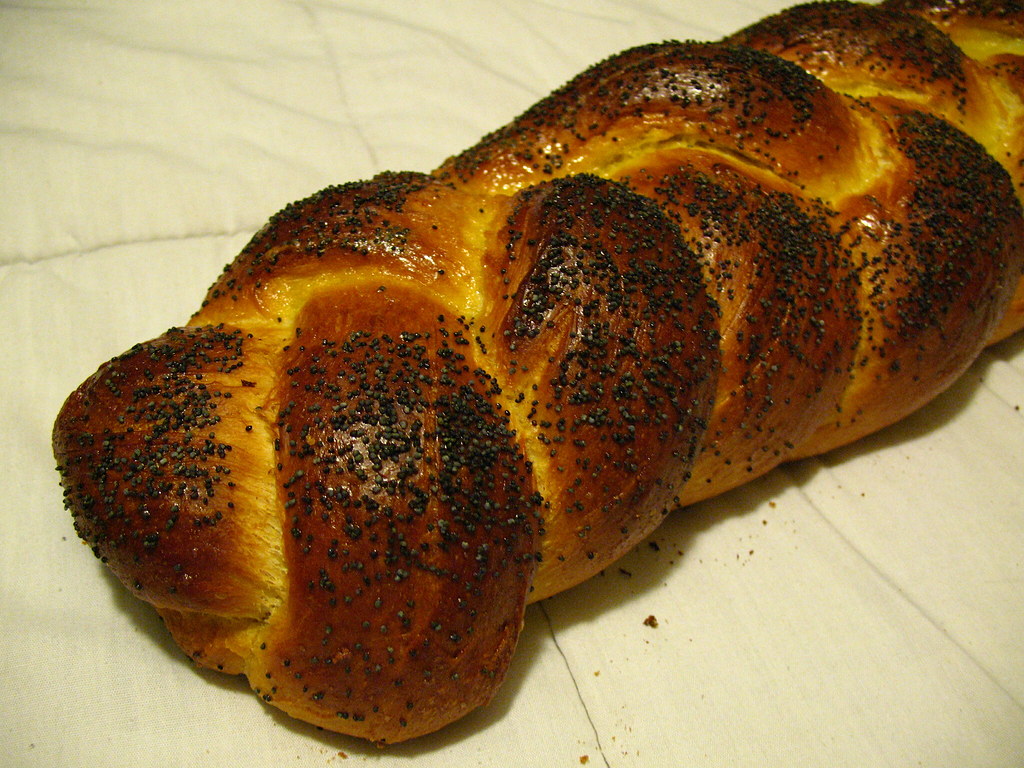
Rebecca's Challah:
Ingredients:
2 pkgs.................Dry Yeast
8 Tsp + .5 Cup........Sugar
~8 Cups................AP Flour
2.25 Cups..............Warm Water (105 - 115 degrees)
.5 Cup..................Vegetable Oil
2 Tbsp..................Kosher Salt
3........................Eggs
1 Tbsp..................Poppy Seeds
Instructions:
Prep [25 Min.]
To start this dough we need to get the yeast to react in water and begin the growth process so they will be at the optimal stage to convert the fermentable sugars and starches from the dough into CO2 when the bread rises and bakes. This is true with all yeasted doughs but in this recipe we hasten this process by adding the yeast, 2 Tsp. sugar, and 2 Tbsp AP flour into a tall water glass and then stirring in .75 Cups of warm water. By setting this mixture aside until it reaches the lip of the glass (in an 80-85 degree environment would be best) you are "proofing" it, or put simply proving that the yeast is ready to do its job. So while your little yeasties are proofing measure out 4 Cups of flour into a large bowl. Add 1.5 Cups warm water, .5 Cups vegetable oil, .5 Cups sugar, salt, and two eggs. Mix thoroughly. When the yeast has proofed sufficiently add it to your bowl. Mix it in and add three more cups of flour gradually. The dough should be shaggy and clean the sides of the bowl.
Kneading [8min.]
Push-fold-turn people. Eight minutes of arm exercise just for you!
First Rising [1.5 - 2 hrs.]
Grease a mixing bowl and put the dough inside. Turn once to coat the dough and keep it from crusting while it rises. Cover with plastic wrap and stick in a warm place (80-85 degrees) until doubled in bulk.
Second Rising [1.5 hours]
Punch down the dough. If it seems to sticky you can add almost .5 Cups to rectify this, don't over knead. Grease the top of the dough again, cover and set back in a warm place to double.
Shaping [depends on your motor skills]
Punch down the dough again and knead to press out the bubbles. Divide the dough in half and then in thirds. Braid each set of three starting in the center and working outwards. Don't forget to pinch the ends and fold under.
Third Rising [1 hour]
Place the two braided loaves on baking sheets and cover with wax paper. If you are worried about the wax paper sticking to the dough you can lightly grease the wax paper. These should again double in bulk.
Baking [350 degrees / 45-55 min.]
While your oven is preheating combine your remaining egg with 6 teaspoons of sugar, brush each loaf, and sprinkle on your poppy seeds. Don't forget that these will rise in the oven, so reserve some of the glaze for halfway through the baking process. These will bake in the oven until golden brown. To test for doneness you can use the toothpick method inserted in a good thick spot where the dough may not have thoroughly cooked. As you know i prefer to use my probe thermometer set to notify at just over 200 degrees. These loaves will be fragile until cooled so be careful not to manhandle them. Use a large spatula to get them off the baking sheet and onto a wire rack to cool.


